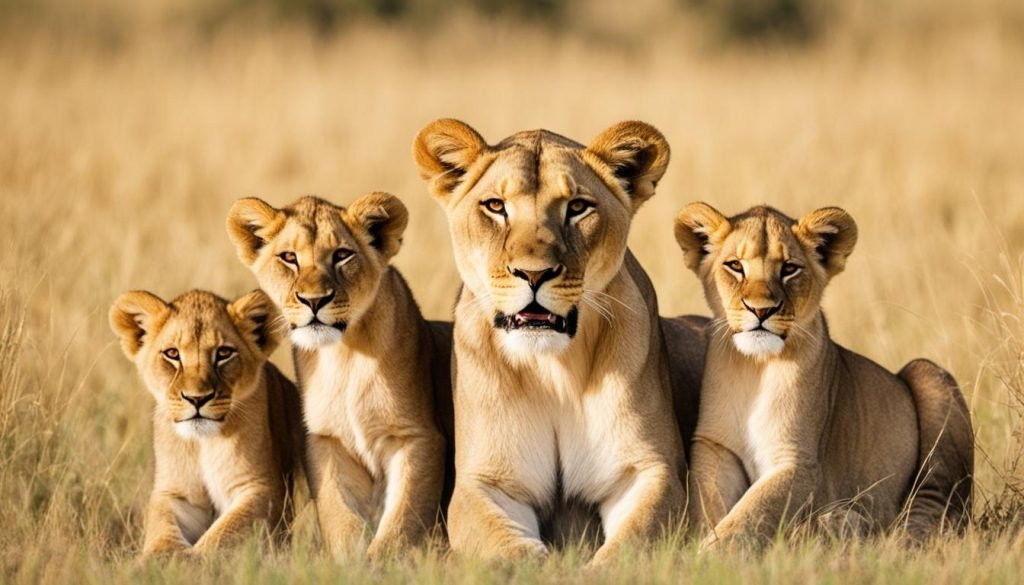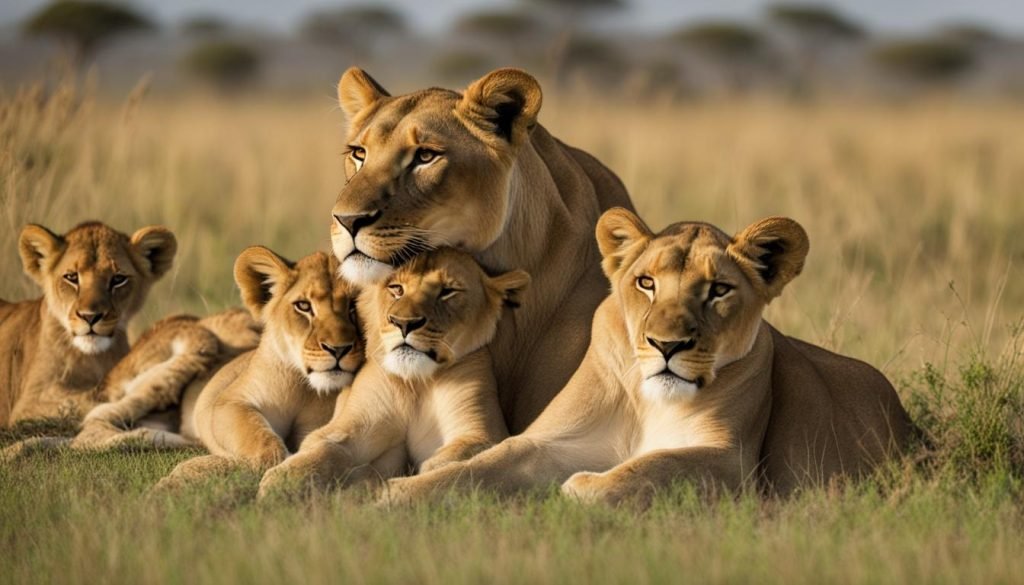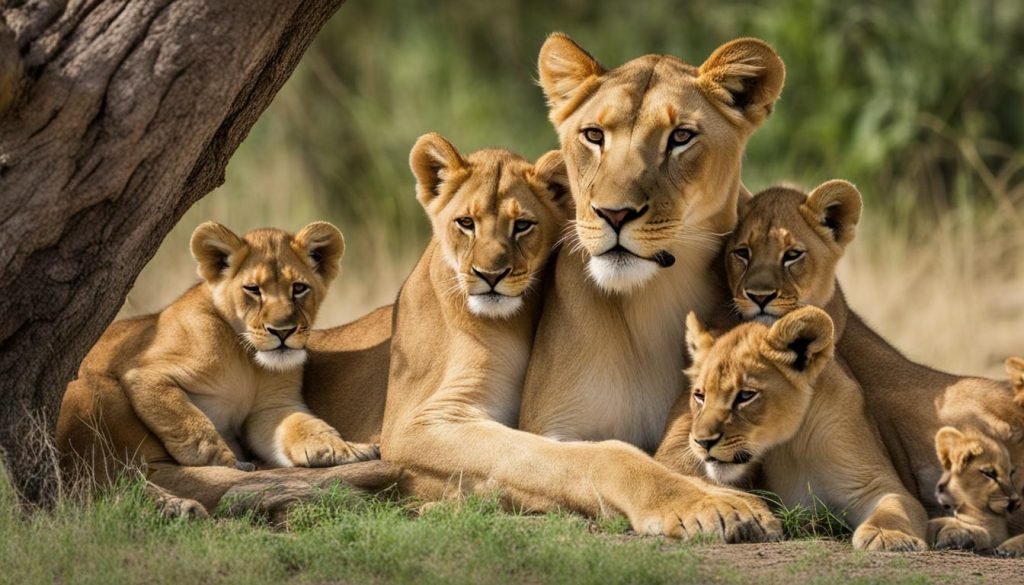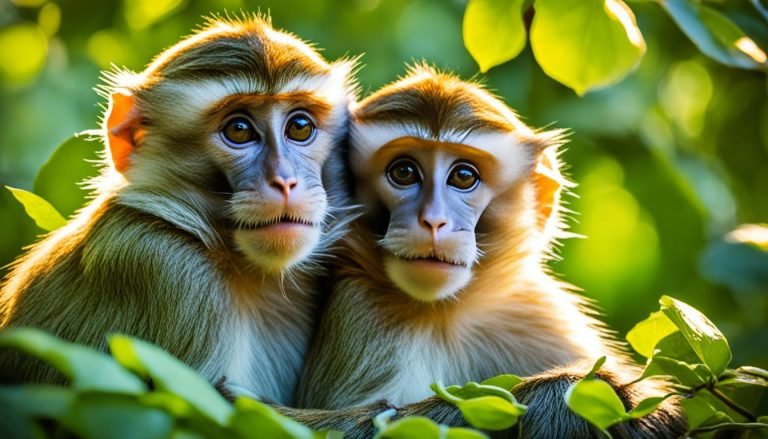How Long Are Lions Pregnant? Gestation Period
Have you ever wondered how long are lions pregnant? The answer may surprise you. Like many other animals, the duration of a lion’s pregnancy varies based on several factors.
In this article, we will uncover the intriguing duration of a lion’s pregnancy. You will learn exactly how long lions carry their cubs and gain insights into the reproductive cycle of these majestic animals.
Key Takeaways:
- The duration of a lion’s pregnancy varies based on several factors
- Female lions can carry their cubs for up to 110 days
- Lion pregnancies are a vital part of maintaining healthy populations of these majestic creatures
- Understanding the reproductive cycle of lions is critical to their conservation
- Environmental conditions and social dynamics can impact a lioness’s pregnancy
Understanding Lion Reproduction
Lions have a fascinating reproductive system that involves a complex cycle of mating behaviors and pregnancy stages. Unlike many other animals, lion mating is not restricted to a specific time of year, with females showing signs of estrus throughout the year.
During mating, males and females engage in various behaviors, including vocalizations, stalking, and fighting. Once a male has successfully mated, he may stay with the pride and play a role in rearing the cubs.
The reproductive system of lions involves a highly specialized anatomy that assists in successful reproduction. Female lions have a uterus with two horns and a single cervix. The males have testes that are located outside the body, which helps maintain an optimal temperature for sperm production.
After mating, the female undergoes a gestation period that typically lasts around 110 days. During this time, the cubs develop inside the uterus and rely entirely on their mother’s body for sustenance.
| Lion Reproduction Cycle | Length of Time |
|---|---|
| Mating | Varies, can last up to several days |
| Gestation | Approximately 110 days |
| Lactation | Up to 6 months |
| Sexual Maturity | 2-3 years for females, 3-4 years for males |
Lionesses usually give birth to litters of around three to four cubs. These cubs are born blind and helpless, relying solely on their mother for nourishment and protection. Within a few months, they begin to move around and explore their environment. Eventually, they become active members of the pride and start to learn the skills necessary to survive in the wild.
Overall, understanding lion reproduction is essential for conservation efforts and the preservation of these magnificent creatures. By understanding the unique mating behaviors and reproductive system of lions, researchers can better manage and protect lion populations.
How Long Are Lions Pregnant? The Lion Gestation Period

Understanding the gestation period of lions is crucial to gaining a deeper insight into these majestic creatures. Female lions carry their cubs for approximately 110 days. During this period, the developing cubs undergo rapid physical and cognitive changes that prepare them for life outside the womb.
As early as day 20, the developing cubs already have discernible spinal cords and bear a resemblance to miniature cats. By day 50, they are fully formed and have grown five times their original size. They have already developed fur, and their movements and senses are more pronounced. By day 80, their bones have hardened, and their movements become more coordinated.
At the end of the gestation period, lionesses give birth to their cubs in secluded areas. The cubs are born blind but have a keen sense of smell, allowing them to locate their mother’s teat and initiate nursing.
It is worth noting that the gestation period of lions can vary slightly from individual to individual. Still, this range of 110 days is considered to be the average duration of pregnancy for female lions.
Factors Affecting Lion Pregnancy

While lionesses have an impressive success rate when it comes to giving birth, several factors can impact their pregnancy and the survival of their cubs. Understanding these factors is crucial for wildlife biologists and conservationists who work to protect these majestic animals. Let’s take a closer look at some of the key factors that can impact lion pregnancy:
- Environmental conditions: Temperature, humidity, and access to water can all affect the health of a lioness during pregnancy. Extreme environmental conditions can lead to dehydration or illness, which can negatively impact a lioness’s ability to carry her cubs to full term.
- Food availability: Adequate nutrition is crucial for healthy fetal development in lions. If a lioness does not have access to enough food during pregnancy, it can lead to stunted growth or birth defects in her cubs.
- Social dynamics: The social hierarchy within a pride can also impact a lioness’s pregnancy. If there is a change in pride leaders or a shift in the social structure, it can cause stress for the lioness, potentially leading to developmental problems for her cubs or even premature birth.
- Genetics: Genetic diversity is important for the long-term survival of the lion population, and inbreeding can lead to health problems for cubs. Wildlife biologists carefully monitor genetics to prevent inbreeding and promote genetic diversity.
By studying these factors and more, we can improve our understanding of lion pregnancy and work to ensure the successful reproduction of these incredible animals.
Signs of Pregnancy in Lions

Identifying a pregnant lion can be challenging, especially in the wild where access is limited. However, there are some physical and behavioral changes that you can look out for, which may indicate that a lioness is carrying cubs.
One of the most visible signs of lion pregnancy is a distended belly. As the cubs grow and develop within the uterus, the lioness’s stomach expands to accommodate them. This can be particularly noticeable in the later stages of pregnancy when the bulge is more pronounced.
Another physical sign to watch for is a swollen vulva. This occurs as a result of hormonal changes in the lioness’s reproductive system and may be an indicator that she is in estrus or has recently mated. Additionally, nipple enlargement and milk production can be observed as the pregnancy progresses, although these signs may not be evident until closer to the time of birth.
In terms of behavioral changes, pregnant lions may become more reclusive, spending more time resting or withdrawing from group activities. They may also display aggression towards other members of the pride, particularly if they feel threatened or stressed.
It’s important to note that these signs of lion pregnancy are not always reliable. Some lionesses may not exhibit any noticeable changes until close to the time of delivery, while others may show physical or behavioral signs that are unrelated to pregnancy. For this reason, it’s essential to consult experienced wildlife experts in identifying pregnant lions accurately.
Lion Cub Development

Watching a lion cub grow and develop is a fascinating experience. From the moment a cub is born, they go through several stages of development as they grow into strong, independent members of the pride.
The newborn cub is entirely dependent on its mother for survival, relying on her for warmth, protection, and milk to sustain them. Over the first few weeks of life, the cub’s eyes and ears become fully functional, and they begin to take their first wobbly steps. By the time they are around two months old, the cub’s have grown their first set of teeth and can begin to eat meat, though they still rely on their mother’s milk for the majority of their nutrition.
As they continue to grow, cubs become more confident and independent, learning from their mother and other members of the pride. They will begin to play-fight and practice their hunting skills, honing their abilities in preparation for adulthood.
By six months of age, lion cubs are highly active and playful, exploring their surroundings and engaging in mock battles with their siblings. As they approach their first year of life, they start to accompany the pride on hunting expeditions, gradually transitioning from playful cubs to skilled predators in their own right.
“Watching lion cubs grow and develop is an amazing experience. From helpless newborns to skilled predators, the process of lion cub development is remarkable to behold.”
The Role of Lionesses in Parenthood
While male lions are often credited with protecting the pride, lionesses play a critical role in nurturing their young. From the moment of birth, lioness mothers devote themselves entirely to the task of caring for their cubs, which often includes nursing up to six times a day, grooming their tiny bodies, and nurturing them through every stage of development.
As the cubs grow, the lioness’s duties expand to include teaching them how to hunt and defend themselves, as well as socializing them with other members of the pride. Additionally, lionesses make significant contributions to their cubs’ survival by ensuring adequate food and water are available and protecting them from potential threats.
Successful reproduction and motherhood are not always easy for lionesses, however. The gestation and birthing processes are physically demanding, and cubs face a high risk of mortality from the moment of birth. Lionesses must navigate challenging environmental conditions, as well as competition from other predators and even other members of their pride, to ensure their cubs survive to maturity.
Despite these challenges, the unique motherly instincts and contributions of lionesses to the parenting journey are invaluable to lion populations in the wild as well as those in captivity. Through their nurturing and selfless devotion, lionesses play a critical role in the survival and ongoing development of their species.
“From the moment of birth, lioness mothers devote themselves entirely to the task of caring for their cubs, which often includes nursing up to six times a day, grooming their tiny bodies, and nurturing them through every stage of development.”
Lioness Motherhood At a Glance
| Responsibilities | Description |
|---|---|
| Nursing | Lioness mothers nurse their cubs up to six times per day in the first few weeks, gradually reducing feeding frequency over time. |
| Grooming | Lioness mothers groom their cubs, removing ticks and other irritants, and keeping their fur clean and dry. |
| Socialization | Lioness mothers facilitate social interaction between cubs and other members of the pride, preparing them for integration into the group. |
| Teaching | Lioness mothers must teach their cubs how to hunt and defend themselves against potential threats, such as other predators or aggressive members of the pride. |
| Protection | Lioness mothers protect their cubs from external threats and other members of the pride, often placing themselves in danger to ensure the safety of their young. |
Lion Pregnancy in Captivity
When breeding lions in captivity, there are a plethora of considerations and challenges faced by zoos and wildlife organizations. One of the most pressing concerns is ensuring the health and well-being of both mother and cubs.
Although it can be easier to monitor pregnant lionesses in captivity, there are still risks involved in the pregnancy and birthing process. For example, lionesses can experience complications during birth such as dystocia, a term used to describe difficulty during delivery.
Additionally, there are ethical considerations surrounding the breeding of lions in captivity. Some conservationists argue that captive breeding programs can create a potential risk of inbreeding, which can result in health issues and reduced genetic diversity in future generations of lions.
| Fact | Lion Pregnancy in Captivity |
|---|---|
| Advantages | Consistent monitoring |
| Controlled environment | |
| Disadvantages | Inbreeding and reduced genetic diversity |
| Potential risks during pregnancy and birthing process |
Despite these concerns, zoos and wildlife organizations have a crucial role to play in conserving lion populations. Captive breeding programs can provide valuable insights into lion reproduction cycles and can offer the opportunity to reintroduce lions into the wild, where their numbers have been in decline due to habitat loss and other factors.
The Circle of Life: Lion Reproduction and Conservation
Understanding the facts about lion pregnancy, breeding, and cub development plays a crucial role in conservation efforts to protect these magnificent animals. Lion populations worldwide have decreased dramatically, leaving these animals vulnerable to extinction.
Effective conservation efforts require a comprehensive understanding of lion reproductive behavior, including their pregnancy cycle, breeding patterns, and cub development. By studying lion pregnancy facts, researchers and wildlife organizations can develop strategies to protect and manage these animals, ensuring their survival for generations to come.
Moreover, conservation efforts must consider the broader ecological impact of lion reproduction and breeding. Lions play an essential role in maintaining ecological balance in their natural habitats, affecting the entire food chain. As apex predators, they control herbivore populations, preventing overgrazing and promoting plant growth.
Conservationists must work together to protect lion populations and their breeding habitats. By protecting the health of lionesses and their cubs during pregnancy and promoting successful breeding, we can help ensure the preservation of these majestic animals and their critical role in our ecosystems.
In conclusion, an understanding of lion pregnancy, breeding, and cub development is essential for protecting these beautiful creatures and preserving our planet’s ecological balance. With concerted conservation efforts and a commitment to understanding these animals’ behaviors, we can ensure that future generations can marvel at the sight of these magnificent creatures roaming free in the wild.
More About Lions:
- Do Lions Eat Humans?
- Cannibalism in Lions: Do Lions Eat Other Lions?
- Do Lions Hibernate During Winter?
- What Do Lions Do All Day?
- How Do Lions Communicate With Each Other?
- What Do Lions Do During the Night?
- Where Do Lions Sleep?
- How Big Can Lions Get?
- How Much Do Lions Weigh? Lion’s Weight Revealed
- How Fast Can Lions Run?
- Can Lions Swim? Lion’s Swimming Ability Examined
- How Long Do Lions Live? Wild vs Captivity







